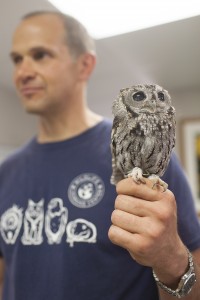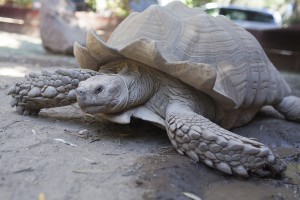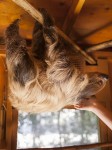There are more than 500 square miles of city surrounding UCLA’s campus, which takes up a minuscule fraction of that mileage. For such a big place, Los Angeles at times seems impossible to navigate. But don’t let size steer you away from your sense of adventure and curiosity. Each week this quarter, follow columnist Maryrose Kulick as she takes you to a new and affordable L.A. destination, to help you explore the city you call home.
Slowly and delicately, Lola reaches her long arms toward the branch above her head and hoists her sandy, fur-covered body up out of her perch by the window. Curious about the new visitors in her home, she dangles lethargically upside down, peering her small beady eyes into mine.

Lola, if you haven’t guessed already, is a sloth. And along with more than 70 other exotic animal species – such as growling alligators, big-eared fennec foxes and striking bald eagles – Lola calls the Wildlife Learning Center, just a 20-minute drive from UCLA, her home.
Walking through the petite area that makes up the center is like entering into an oasis of lush greenery. Here at UCLA we’re surrounded by brick buildings and concrete sidewalks – the most wildlife we see is squirrels jumping out of trashcans. In contrast, the Wildlife Learning Center is a whole new world that feels a thousand miles away from our noisy dorm halls and tedious lecture notes. It’s a calming excursion that’ll make you expect to hear “The Jungle Book” soundtrack playing in the background.
Paul Hahn and UCLA alumnus David Riherd founded the Wildlife Learning Center as a nonprofit sanctuary for displaced animals. Like Lola the sloth and Fluffy the alligator, many animals here are former house pets. Others were found with injuries that prevented them from returning to the wild. Now most of them will make their permanent homes under the care of biologists working at the center.
Before my visit to this intimate and wild setting, I failed to adequately prepare for the wide spectrum of critters I was about to meet. At the Wildlife Learning Center, you’ll be introduced to animals from practically all over the world. Merlin the brightly colored macaw greets you as you enter, squirrel monkeys hop from tree to tree in their enclosure and porcupines curl up for an afternoon nap – a dream come true for a nature lover in a big city.

The staff of biologists is made up of an extremely friendly group of faces willing to answer any kind of question you might have about the animals. “Where did they come from? What kind of food do they eat? Why is a legless lizard not a snake? Will that 16-foot python get any bigger?” These all have answers that the curious naturalist inside of you absolutely has to know.
To give an even more personal experience, biologists hold hourly “trainer talks” and bring out individual animals, allowing visitors to observe them up close and even touch them while using a two-finger technique. I met a Brazilian rainbow boa whose dazzling scales reflected back glimmering purples, blues and greens.
If you want to get closer to some of the larger animals, you can pay a fee on top of the general admission and take part in one of the “animal experiences.” You can interact with characters like Lola, a Siberian lynx named Boomer and many more. A biologist will take you and your group to the enclosure, teach you about the animal in question and let you touch or feed it depending on the animal you are seeing. Have you ever felt how soft a Siberian lynx’s coat is? Take my word: It’s pretty darn soft.
You can find a complete list of animal experiences offered on the Wildlife Learning Center website, and on Oct. 25, if you don’t want to spend all your money on just one animal, the center will be holding its Safari Social, a fundraiser event where you can interact with not one but at least eight different animal. Plus, flash your BruinCard and you’ll get a $10 discount to hang out and make friends with cute, fuzzy and sometimes scaly critters that make up just a small part of Earth’s huge range of biological diversity.
Even if you just browse through the habitats on your own, the Wildlife Learning Center provides a distinctive Los Angeles experience for nature enthusiasts. So take this chance to take a break from urban living – for even just a moment – and go find your wild side.
